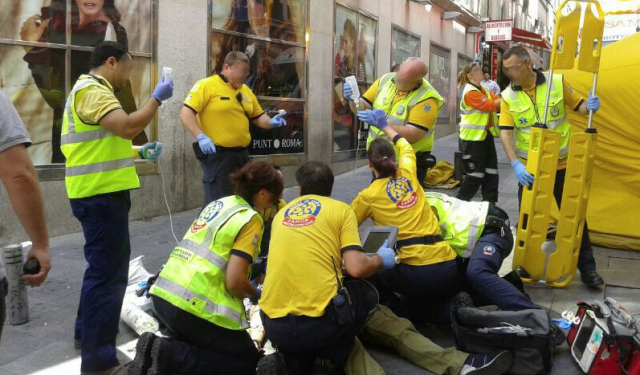
Since point-of-care ultrasound systems were originally designed for dealing with emergencies in a battlefield setting, it's not surprising that ultrasound now plays a pivotal role in emergency vehicles around the world. Dr Ramón de Elías Hernandez, head of on-call doctors at SAMUR, Madrid’s municipal emergency service, describes the advantages that point-of-care ultrasound brings to his everyday life.
"I've been an ambulance doctor for the Servicio de Asistencia Municipal de Urgencia y Rescate (SAMUR) in Madrid for 20 years, 10 of those as head of on-call doctors. My day job is to attend patients, almost always healthy people who are just walking along the street and have an accident or are taken ill. At any time, there are two on-call doctors covering the city and going where they are most needed, usually for cases with more medical or organisational complexity.
"Every day, SAMUR has around 50 ambulances and all-terrain vehicles on stand-by, based at waiting centres in each of the 21 areas of Madrid, with up to 15 of these accompanied by a doctor. Ambulance crews are dispatched according to the seriousness of the incident, or geographical proximity, and operate under a ‘two-step’ system, where those first on the scene can assess the situation and request assistance from other teams if necessary. About 15 years ago, standard procedures were established for the different pathologies we encounter, including basic guidelines for diagnosis and treatment, which drugs to use and where to take the patient, etc. These procedures now include ultrasound, recommending when and how to use it and, for the last 10 years, we have held in-house training and annual refresher courses for all our doctors. All the vehicles are fully equipped with analytical equipment, including Sonosite point-of-care ultrasound systems, used constantly in a range of situations.
"在任何紧急情况下,响应时间都很重要,例如对于严重的交通事故,在六七分钟内做出响应可让团队有更大的机会稳定患者,避免伤势过度恶化。在这种情况下使用超声技术,特别是对于胸腹部创伤,有助于为严重受伤的患者赢得更多时间。FAST 方案可排除或确认血胸、心包出色和腹腔积血,并决定下一步措施。我们可以通知医院多处严重受伤的患者的状况,并在他们病情不稳定、存在出血迹象和血流动力学不稳定时提前发出无线电信息,以便直接为他们安排紧急手术。当然,我们还有更传统的常规检查技术 – 触摸、感觉和听诊 – 但无疑超声可让我们看到正在发生的情况。我们不仅将其用于诊断,还用于预防并发症,例如使用 M 模式检测潜在的隐藏气胸。在其众多可能性中,另一种是如今在院外医学中可通过超声技术引导中央或外周静脉导管放置,这是我们对很多患者实施的重要手术。同样对于呼吸心跳骤停,超声也变得越来越重要;我们可以完美地了解心脏是否正确地收缩或已完全停止跳动,同时还可引导心脏按摩,并且在心脏骤停的情况下监测脉搏的效率要高得多。我们的方案还包括执行心脏超声检查,以在急性心肌梗死中出现纤维蛋白溶解之前排除心包出血。
"在救护车中提供医疗点超声设备具有很大的优势,可帮助我们在复杂的环境中诊断和治疗患者,并可对患者产生连锁反应;这种无创技术不会产生伤害,可使患者和医生在紧张的情景中更加自信。它还极具成本效益,在初始投资之后不会产生其他成本。我们的 Sonosite 系统非常坚固,极其适合有时系统就那样丢在地上 – 甚至是在雨中 – 或闲置不用的恶劣环境,然而我们几年前购买的所有系统都仍然可以完美地运行。设备本身很容易处理,带来的优点越来越多,我完全可以期待更多的此类设备出现在多种医疗环境中,而不仅限于紧急护理。"
了解关于急诊医学环境中的超声应用的更多信息
紧急服务团队需要可靠的工具,以在一些可以想象的最严重外伤性条件下为患者提供帮助。十多年来,急救人员在紧急情况下一直利用 Sonosite 轻盈而耐用的超声系统进行伤检分类和医疗点诊断。了解关于 Sonosite 可为紧急医疗服务提供的定制产品范围的更多信息。


